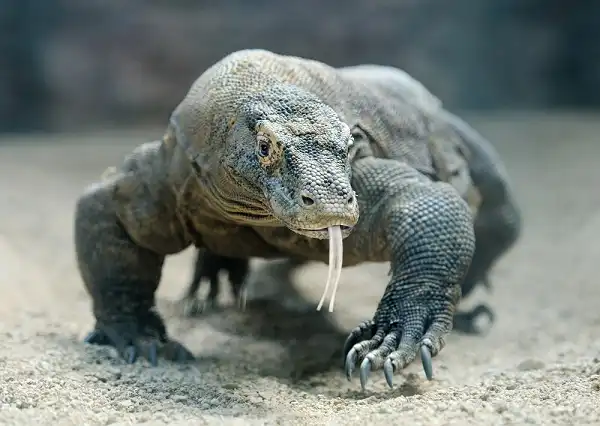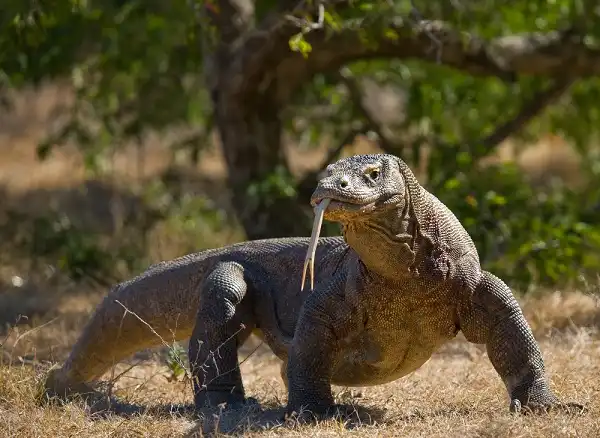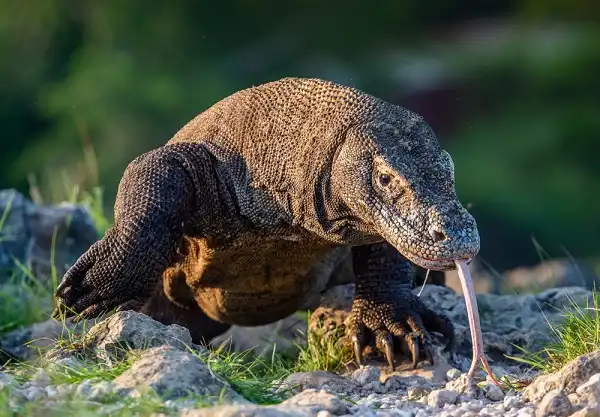The Komodo dragon is a fascinating, prehistoric creature with an incredible ability to survive despite its vulnerable status in the world today. Found primarily on several small Indonesian islands, the Komodo dragon’s fierce predatory nature and muscular physique have earned it a reputation as one of the most impressive apex predators around. Despite their size and ferocity, however, these reptiles are incredibly elusive creatures and only recently made themselves known to mankind — making them all the more remarkable! Within this blog post, we’ll discuss why they’re so special and why they deserve our protection. Read on to learn more about this unusual species that many consider “living dinosaurs!”

Komodo Dragon Description
The Komodo dragon possesses a number of unique physical characteristics. Their muscular bodies are covered in tough, scaly skin, which provides protection from other predators and helps retain moisture in their arid island habitat. One of the most notable features of the Komodo dragon is its powerful jaws, armed with serrated teeth that can tear flesh with ease. The dragon’s saliva contains a potent mix of bacteria that serves as a deadly venom, causing the prey to become weakened and disoriented. Overall, the Komodo dragon’s physical characteristics make it one of the most impressive creatures on the planet. However, their limited range and vulnerable status mean that they require protection if they are to survive in the wild. By learning about these fascinating animals and supporting conservation efforts, we can help ensure that these magnificent species continue to thrive for generations to come.
Komodo Dragon Habitat
The Komodo dragon is only found in a limited number of small Indonesian islands, including Komodo Island, Rinca Island, Gili Motang, and Flores Island. These islands have a unique ecosystem that provides the perfect habitat for the Komodo dragon to thrive. They prefer dry open grasslands, savannahs, and tropical forests, as these environments provide ample opportunities for hunting and a steady source of food. With temperatures ranging from 20°C to 35°C, these islands offer optimal conditions for the cold-blooded Komodo dragon to regulate its body temperature.
Despite being the top predator on their islands, the Komodo dragon is not without its challenges. Their habitat is threatened by human activity, habitat destruction, and poaching. The ongoing development of infrastructure, mining, and agriculture further exacerbates the challenges faced by this species. In addition, the Komodo dragon is highly susceptible to infectious diseases, which can decimate its population quickly. The combination of these factors results in a vulnerable species that requires our immediate attention and protection.
Komodo Dragon Diet
Komodo dragons have a varied diet that ranges from small mammals to large prey like deer and water buffaloes. They are apex predators that can take down games larger than their own size, making them a fearsome predator. Their sharp teeth, powerful jaws, and venomous saliva are their primary weapons, which they use to kill their prey quickly and efficiently. Komodo dragons are also opportunistic in their feeding behavior, and they will eat carrion when the opportunity arises. They have a keen sense of smell that allows them to detect carrion from long distances, and they will scavenge on anything from small animals to large carcasses. This makes them an essential part of the ecosystem as they act as scavengers, keeping the environment clean of dead and decaying matter.

Komodo Dragon Size
The Komodo dragon, also known as Varanus komodoensis, is the largest living lizard on Earth. Adult Komodo dragons can grow up to 3 meters in length and weigh as much as 70 kilograms. These fascinating creatures have long, muscular tails, powerful legs, and sharp claws that make them formidable predators. The size of the Komodo dragon is a direct result of their environment and their predatory lifestyle. They require a large body size to catch and kill their prey efficiently. Their powerful jaws and sharp teeth allow them to take down animals much larger than themselves, and their venomous saliva helps them to subdue their prey. Interestingly, Komodo dragon hatchlings are born relatively small compared to their adult counterparts, measuring only around 40 centimeters in length and weighing just a few grams. The impressive size of the Komodo dragon is a vital adaptation that allows them to be successful predators. However, their size also makes them susceptible to human impacts on their environment.
Komodo Dragon Lifespan
Komodo dragons have a relatively long lifespan, with some individuals living up to 30 years in the wild. However, many factors can affect their lifespan, including their size, health status, and environmental conditions. Like other reptiles, Komodo dragons have a slow metabolism, which means they age at a slower rate than mammals. This slower metabolic rate also affects their growth rate, which is why it can take up to 10 years for them to reach their full size. Komodo dragons also have impressive regenerative abilities, allowing them to heal quickly from injuries or illnesses. This remarkable skill ensures that even in the wild, where the risk of injury is high, they can continue to thrive and survive. In captivity, the lifespan of Komodo dragons can be much longer than in the wild, with some individuals living up to 50 years. This is because they receive specialized care and medical attention, which can help manage any health issues that may arise.
Komodo Dragon Behavior
Komodo dragons are fascinating creatures with unique behaviors that have evolved to help them survive in their harsh environments. One of the most notable behaviors of these giant lizards is their ability to hunt cooperatively. In cooperative hunting, Komodo dragons work together to take down larger prey that may be beyond the capabilities of a single dragon. They communicate through a combination of visual signals, body language, and scent marking. During a hunt, the dragons may use ambush tactics or take turns distracting and attacking the prey. This type of hunting is thought to be one of the reasons why Komodo dragons have been such successful predators for millions of years.

Komodo Dragon Speed
Komodo dragons may not be the fastest creatures on land, but their unique hunting techniques and impressive strength more than compensate for their speed. These giants can reach speeds of up to 20 kilometers per hour (12 miles per hour) in short bursts, making them capable of chasing down prey over short distances. However, where Komodo dragons really excel is in their ambush tactics. With their sharp claws, powerful jaws, and muscular tails, they can quickly move from a stationary position to an explosive attack. Their unique hunting methods, including their cooperative hunting behavior and their use of venomous saliva to weaken prey, make them highly successful predators. Interestingly, Komodo dragons are also known to be excellent swimmers, and have been known to swim between islands in search of food or mates. Their powerful legs and tails allow them to move quickly through the water, making them formidable predators even in this environment.
Komodo Dragon Hunting
Komodo dragons typically hunt alone, using their keen senses and impressive strength to ambush prey. However, they have also been observed working cooperatively in groups of up to 12 individuals to bring down larger prey. In these cases, the dragons may use ambush tactics or take turns distracting and attacking the prey. This type of hunting is thought to be one of the reasons why Komodo dragons have been such successful predators for millions of years. Komodo dragons will also fight amongst themselves for access to food or mating privileges. This can include fighting with other males, scratching and biting, and even pushing smaller males away from females.
Komodo Dragon Reproduction
Komodo dragon mating takes place between May and August, with females reaching sexual maturity at 4-5 years of age. Males become mature at about 8-9 years old. During this time, males will establish territories in which they can defend access to female mates. Female Komodos usually lay up to 20 eggs per clutch, nesting in sandy or muddy areas near the beach. The eggs take 7-8 months to incubate before hatching. After hatching, the young Komodos are on their own and must fend for themselves. They are vulnerable to predation by birds of prey and other predators, so the survival rate is low during their first few years of life. As they get older, however, their size and strength make them more formidable, allowing them to survive into adulthood.

Komodo Dragon Interactions with Humans
Though Komodo dragons are not a threat to humans, they can be dangerous if provoked. Their sharp claws and powerful jaws make them capable of serious injury or death if threatened. If encountered in the wild, people should always maintain a safe distance and never attempt to approach a dragon. Komodo dragons have been known to harass fishermen along the shores of their native habitat, stealing fish from nets and boats. People living near Komodo dragon habitats have developed various strategies for protecting themselves from these animals, such as keeping dogs around to scare away intruders. Komodos are also popular attractions for tourists visiting Indonesia, with viewing platforms set up for hikers and nature enthusiasts. Local authorities ensure that visitors stay at a safe distance and are not in danger of being attacked by the dragons.
Conclusion
Komodo dragons are an iconic species that have been around for millions of years. They are known for their sharp claws, powerful jaws, and muscular tails which they use to ambush prey. They also cooperate in groups when hunting larger animals and use their tongues to gather information about their surroundings. While they may not be the fastest creatures on land, Komodo dragons are highly successful predators due to their impressive strength and unique hunting techniques. Preserving their habitats is essential in order to protect these fascinating reptiles and ensure their continued survival as a vital part of the ecosystem.
Frequently Asked Question

